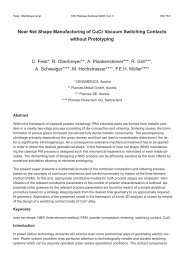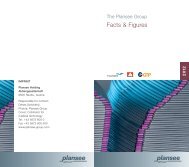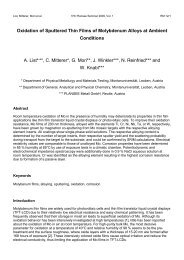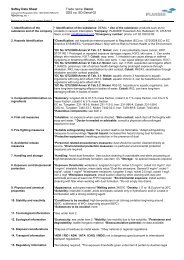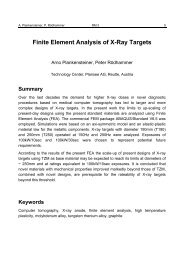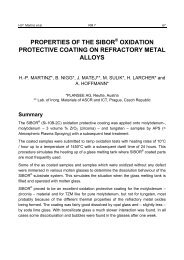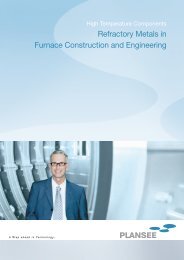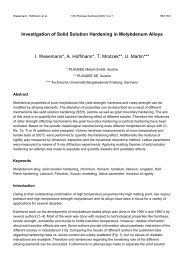Surface Hardening of Complex Molybdenum Alloy Parts by Gas ...
Surface Hardening of Complex Molybdenum Alloy Parts by Gas ...
Surface Hardening of Complex Molybdenum Alloy Parts by Gas ...
You also want an ePaper? Increase the reach of your titles
YUMPU automatically turns print PDFs into web optimized ePapers that Google loves.
Nigg, Martinz and Lechleitner 17th Plansee Seminar 2009, Vol. 1 RM 55/1<br />
Abstract<br />
<strong>Surface</strong> <strong>Hardening</strong> <strong>of</strong> <strong>Complex</strong> <strong>Molybdenum</strong> <strong>Alloy</strong> <strong>Parts</strong> <strong>by</strong> <strong>Gas</strong><br />
Treatment<br />
B. Nigg*, H.-P. Martinz* and A. Lechleitner*<br />
* PLANSEE SE, Reutte, Austria<br />
<strong>Molybdenum</strong> is the high end material for hot runner nozzles (HRNs) when they are used for injection<br />
moulding <strong>of</strong> corrosive polymers. For better abrasion resistance in addition the outer but especially the<br />
inner surfaces <strong>of</strong> the molybdenum nozzle are hardened <strong>by</strong> SHN ® ( = Super Hard Nitride), a gas nitriding<br />
process. To access longer lifetimes <strong>of</strong> the hot runner nozzles within this work attempts have been made<br />
to enlarge the hardness, to enlarge the thickness and to improve the oxidation resistance <strong>of</strong> the<br />
hardened zone. Variations <strong>of</strong> the process parameters as well as additions <strong>of</strong> elements like carbon or<br />
silicon resulted in reasonable improvements <strong>of</strong> surface properties.<br />
Keywords<br />
<strong>Molybdenum</strong>, TZM, SHN, gas nitriding, oxidation, hardness, pack siliconizing<br />
Introduction<br />
<strong>Molybdenum</strong> and its alloys (like TZM) are the high end materials for hot runner nozzles when they are<br />
used for injection moulding <strong>of</strong> corrosive polymers. For better abrasion resistance in addition the outer but<br />
especially the inner surfaces <strong>of</strong> the molybdenum (alloy) nozzle are hardened <strong>by</strong> SHN ® ( = Super Hard<br />
Nitride), a gas nitriding process which has been derived from literature and internal experience [1 – 5].<br />
As has been stated in the preceding publication <strong>of</strong> this group [6] the hardness pr<strong>of</strong>ile and the oxidation<br />
resistance <strong>of</strong> the surface zone should be improved in order to enlarge lifetime <strong>of</strong> the HRNs (Hot Runner<br />
Nozzles) which are used in plastics injection moulding (PIM) to provide a reproducible connection<br />
between feedstock and moulds. For that reason process parameters have been varied and the elements<br />
carbon (hardness) and silicon (oxidation resistance; [7]) have been implemented into the hard layer.<br />
Experimental<br />
TZM samples were disc like for the parameter variations and the addition <strong>of</strong> methane to the ammonia<br />
and tube shaped with various diameters for the experiments where silicon was added to the diffusion<br />
layer. Table I shows the parameters <strong>of</strong> the experiments which were performed. The hardened samples<br />
were evaluated <strong>by</strong> macroscopy, XRD ( = X-Ray Diffraction) and cross sectioning with subsequent LOM
RM 55/2 17th Plansee Seminar 2009, Vol. 1 Nigg, Martinz and Lechleitner<br />
( = Light Optical Microscopy), SEM-EDX ( = Scanning Electron Microscopy – Energy Dispersive X-Ray<br />
Analysis) and hardness measurements <strong>by</strong> a Nanoindenter.<br />
Results and discussion<br />
The standard SHN process on TZM leads to the formation <strong>of</strong> a zone which mainly consists <strong>of</strong> Mo2N [6].<br />
Table I and fig. 1 show that the substrate below this zone is also hardened slightly. However in a depth<br />
<strong>of</strong> 40 µm below the interphase the hardness is approximately as low as in the bulk substrate material. In<br />
fig. 2 light optical micrographs <strong>of</strong> two cross sections can be seen: on the left hand side that <strong>of</strong> a standard<br />
SHN sample, on the right hand side that <strong>of</strong> an high temperature (HT) SHN sample.<br />
Table I: Process parameters and results <strong>of</strong> the various hardening processes<br />
process <strong>Gas</strong> / Pack Temperature mass gain thickness <strong>of</strong> HV* in HV* - 10µm HV* - 40µm HV* - 100µm<br />
denomination composition in °C in mg / cm 2<br />
standard SHN<br />
zone in µm hardened zone deep in base deep in base deep in base<br />
TZM<br />
HT SHN<br />
NH3 1000 1,05 16 16 6 3,5 3<br />
TZM<br />
Carbo SHN<br />
NH3 1200 1,55 12 17 8 7,5 7<br />
TZM<br />
Silico SHN<br />
NH3 + CH 4 1100 0,70 11,5 17 7 5 3<br />
Mo Si + NaF + H2 1100 10,00 30 14 2,9 2,9 2,7<br />
NH3 1000<br />
1800<br />
1600<br />
1400<br />
1200<br />
1000<br />
800<br />
600<br />
400<br />
Hardness<br />
(HV 0,01)<br />
in kg/(mm) 2<br />
* all HV ( = Vickers Hardness) values in GPa<br />
Hardness vs. Depth - SHN<br />
-15 -10<br />
200<br />
-5 0 5 10 15 20 25 30 35 40 45 50 55 60 65 70 75 80 85 90<br />
Depth (µm) from the interface<br />
Fig. 1: Hardness pr<strong>of</strong>ile for two TZM samples hardened with the standard SHN process<br />
Hardness sample 1<br />
Hardness sample 2
Nigg, Martinz and Lechleitner 17th Plansee Seminar 2009, Vol. 1 RM 55/3<br />
Fig. 2: Light optical micrograph <strong>of</strong> cross sections <strong>of</strong> a standard SHN (left) and a HT-SHN (right) TZM sample<br />
The HT (1200°C) SHN process leads to a less homogeneous diffusion zone with a lower mean<br />
thickness. However the hardness pr<strong>of</strong>ile is different (see table I and fig. 3): starting from a slightly higher<br />
hardness <strong>of</strong> the diffusion zone even in a <strong>of</strong> depth 100 µm from the interface the TZM exhibits a hardness<br />
<strong>of</strong> 700 kg/(mm) 2 , which is more than double compared to the bulk value (300 at approx. 200 µm depth).<br />
1800<br />
1600<br />
1400<br />
1200<br />
1000<br />
800<br />
600<br />
400<br />
Hardness<br />
(HV 0,01)<br />
in kg/(mm) 2<br />
Hardness vs. Depth HT - SHN<br />
200<br />
-25 -15 -5 5 15 25 35 45 55 65 75 85 95 105 125 145 165 185 205 225 245 265 285 305 325 345<br />
Depth (µm) from the interface<br />
Fig. 3: Hardness pr<strong>of</strong>ile for two TZM samples hardened with the HT SHN process<br />
Hardness sample 1<br />
Hardness sample 3<br />
This is a very promising result. Less successful was the carbo nitridation at 1100°C. Although the<br />
diffusion layer which was formed is rather uniform (fig. 5, left) the hardness pr<strong>of</strong>iles look very different<br />
depending on the location where they were measured (fig. 4). As the carbo nitrided samples showed<br />
locally blackened areas soot formation from the gas phase can be assumed. This can probably be<br />
suppressed <strong>by</strong> lowering the methane content in the gas mixture so that more uniform hardening<br />
conditions can be established in future. XRD measurements revealed that Mo2C, MoC, MoN and locally<br />
Mo2N contribute to the composition <strong>of</strong> the hard zone. This mixture is slightly less hard than the hard
RM 55/4 17th Plansee Seminar 2009, Vol. 1 Nigg, Martinz and Lechleitner<br />
zones formed <strong>by</strong> ammonia exposure (Mo2N, much less MoN). The right hand sided light optical<br />
micrograph <strong>of</strong> fig. 5 was prepared from a pack siliconized Mo sample which was subsequently submitted<br />
to a standard SHN process. The horizontal thick layer on top consists mainly <strong>of</strong> MoSi2, the greyish<br />
uneven phase on top is most probably Si3N4 (XRD – results). The vertical zone was formed during the<br />
SHN process on the pure cutted Mo surface: it consists mainly <strong>of</strong> Mo2N.<br />
1800<br />
1600<br />
1400<br />
1200<br />
1000<br />
800<br />
600<br />
400<br />
Hardness<br />
(HV 0,01)<br />
in kg/(mm) 2<br />
Hardness vs. Depth - Carbo-SHN<br />
-15<br />
200<br />
-5 5 15 25 35 45 55 65 75 85 95 105 115 125 135 145 155 165 175 185 195 205<br />
Depth (µm) from interface<br />
Fig. 4: Hardness pr<strong>of</strong>ile for two TZM samples hardened with the HT SHN process<br />
Hardness 3 long. a<br />
Hardness 3 long. b<br />
Hardness 3 transv.<br />
Fig. 5: LO micrograph <strong>of</strong> the cross section <strong>of</strong> a carbo nitride TZM (left) and <strong>of</strong> a silico nitrided Mo (right) sample
Nigg, Martinz and Lechleitner 17th Plansee Seminar 2009, Vol. 1 RM 55/5<br />
Fig. 6 shows the hardness pr<strong>of</strong>ile through the silicide zone down to the Mo substrate. There is a thin<br />
layer in between, most probably Mo5Si3 (EDX). As can be seen also from table I the hardness has a<br />
steep gradient into the molybdenum substrate. The layer hardness is lower compared to the nitrided or<br />
carbo nitrided substrates. This may – to a small extent – be caused <strong>by</strong> the s<strong>of</strong>ter base material Mo<br />
instead <strong>of</strong> TZM. From literature [7] it is known that MoSi2 should be s<strong>of</strong>ter than Mo nitrides or Mo<br />
carbides, but much more oxidation resistant. The pack siliconizing <strong>of</strong> the samples was performed in a<br />
way that the inner volume was not filled with pack mixture in case <strong>of</strong> the long and thin tubes (fig. 7, left).<br />
Nevertheless the inner cylindrical surface (diameter 2.4 x length 23.2 mm 3 ) was siliconized completely <strong>by</strong><br />
the evaporation <strong>of</strong> silicon fluoride which is formed from NaF and Si. The thickness <strong>of</strong> the silicide layer<br />
inside the long tube <strong>of</strong> fig. 7 lies between 20 and 50 µm (fig. 8). This result is important because the real<br />
parts which eventually have to be hardened in that way – the HRNs (Hot Runner Nozzles; fig. 7, right) –<br />
also have thin channels. More work must be done especially to control the thickness distribution and<br />
roughness <strong>of</strong> the layers, furthermore to check the oxidation and abrasion resistance.<br />
1600<br />
1400<br />
1200<br />
1000<br />
800<br />
600<br />
400<br />
200<br />
0<br />
Hardness<br />
(HV 15mN)<br />
in kg/(mm) 2<br />
-60 -40 -20 0 20 40 60 80 100 120<br />
Fig. 6: Nanoindentation Hardness pr<strong>of</strong>ile for a sample hardened with the silico SHN process<br />
Summary and outlook<br />
Hardness vs. Depth - Silico SHN<br />
Depth [µm] from the interface<br />
Up to now for the plastic injection moulding <strong>of</strong> very corrosive and abrasive polymer melts TZM<br />
or SHN treated TZM HRNs are used. For further improvement <strong>of</strong> the standard SHN diffusion<br />
layer various measures were performed and evaluated: Higher process temperatures for SHN<br />
lead to a flater hardness pr<strong>of</strong>ile, addition <strong>of</strong> hydrocarbon to the ammonia and a higher process<br />
temperature show a comparable, but significantly weaker effect and – finally – silico nitriding (in<br />
two steps) causes a modified silicide layer which has to be investigated intensely and optimized<br />
in future.
RM 55/6 17th Plansee Seminar 2009, Vol. 1 Nigg, Martinz and Lechleitner<br />
Fig. 7: Macros <strong>of</strong> silico SHN treated Mo tubes (left) and <strong>of</strong> a variety <strong>of</strong> TZM HRNs for PIM application<br />
Fig. 8: LO micrograph <strong>of</strong> the cross sections <strong>of</strong> a silico nitrided Mo tube: longitudinal (left), transversal (right)<br />
References<br />
1. H.-P. Martinz and K. Prandini, Int. J. <strong>of</strong> Refractory & Hard Materials 12, pp.179 – 186 (1994)<br />
2. I. Jauberteau., J.L. Jauberteau, M. Cahoreau and J. Aubreton, Appl. Phys. 38, pp. 3654 – 3663<br />
(2005)<br />
3. Y. M. Lakhtin and Y. D. Kogan, Metal Science and Heat Treatment 10 / 1, pp. 24 – 28 (1968)<br />
4. T. Nakajima and T. Shirasaki, J. Electrochem. Soc. 144 /6, pp. 2096 – 2100 (1997)<br />
5. W. D. Sproul, Contract No. NAS 8-37686 – Final Report for NASA Marshall Space Flight Center<br />
(1993)<br />
6. H.-P. Martinz and B. Nigg, Proceedings 20 th International Conference on <strong>Surface</strong> Modification<br />
Technologies, Vienna, pp. 100 – 106, ASM (2006)<br />
7. D. Manomaisupat, D.S. Wilkinson and A. Petric, Journal <strong>of</strong> Materials Science, Volume 33, Number<br />
9, pp. 2319-2330 (1998)





